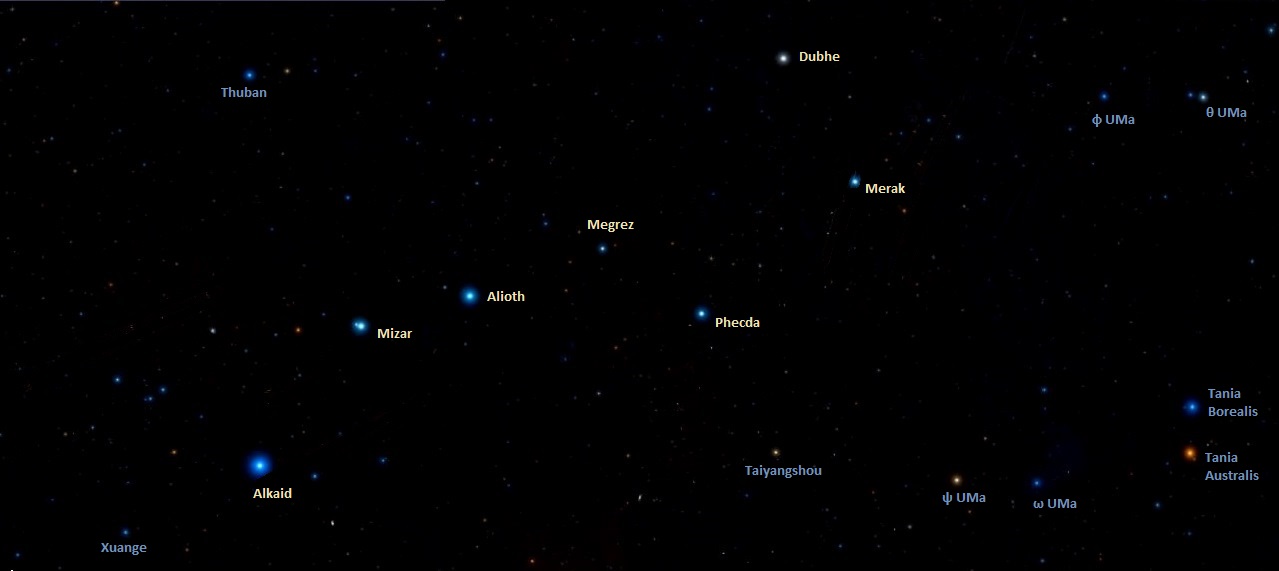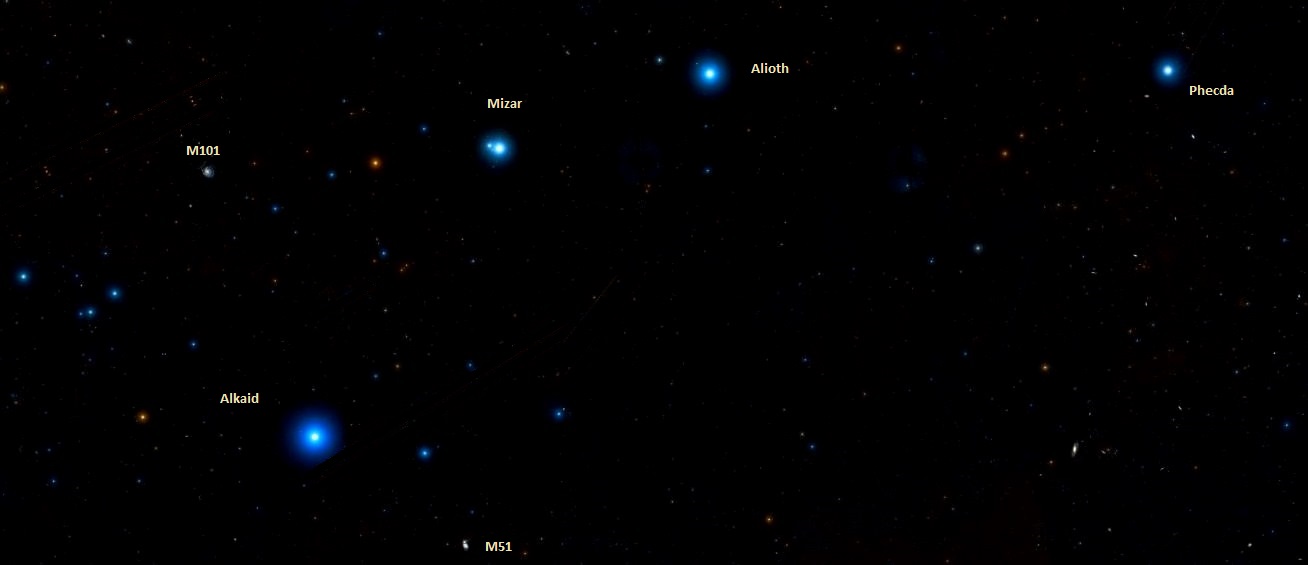Mizar, Zeta Ursae Majoris (ζ UMa), is a quadruple star system in Ursa Major. It has a combined apparent magnitude of 2.04 and lies at a distance of 82.9 light years from Earth. It is the fourth brightest star in Ursa Major.
Mizar is the middle star of the Big Dipper‘s handle and it forms a visual double with Alcor, a fainter binary star located at a separation of about 12 arcminutes.
Star system
The Zeta Ursae Majoris star system consists of two pairs of spectroscopic binary stars appearing as a visual double star. The system is an excellent target for small telescopes. The two main components are separated by only 14.4 arcseconds. They are referred to either as Zeta Ursae Majoris A and Zeta Ursae Majoris B or as Zeta1 Ursae Majoris and Zeta2 Ursae Majoris. They are also commonly called Mizar A and Mizar B.
The four components of the system are designated as Zeta Ursae Majoris Aa, Ab, Ba and Bb. The entire star system has the Hipparcos designation HIP 65378, but the components are catalogued separately in the Bright Star Catalogue (BSC) and the Henry Draper Catalogue (HD).
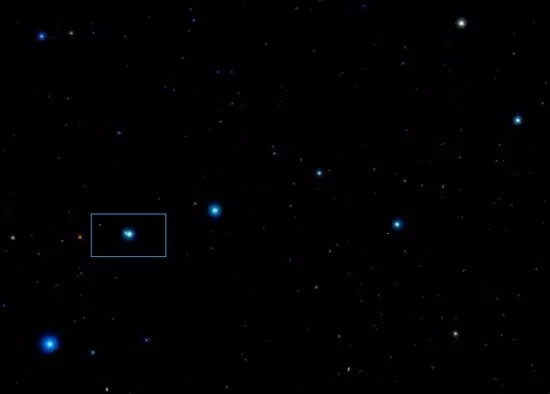
Mizar (Zeta Ursae Majoris), image: Wikisky
Mizar A and Mizar B take 5,000 or more years to complete an orbit and come within 380 astronomical units of each other.
Mizar Aa and Mizar Ab – the two components of Mizar A – have roughly the same mass (2.2 times that of the Sun), radius (2.4 times solar), temperature (9,000 K), and luminosity (33.3 solar luminosities). The stars’ masses differ only very slightly – Mizar Aa has 2.2224 solar masses and Mizar Ab has 2.2381 – and reflect the slight variations in the stars’ radial velocities. The stars orbit each other with a period of 20.586 days (20 days, 12 hours and 55 minutes). Their estimated age is 370 million years.
Both stars have the stellar classification A2Vp, which means that they are hydrogen-fusing dwarfs, appearing white or blue-white in colour. The “p” indicates that the stars are chemically peculiar. They are both Ap stars, which exhibit overabundances of certain metals in the photosphere and tend to spin more slowly than other class A stars. Ap stars also tend to have stronger magnetic fields than regular class A stars. The two components of Mizar A both show overabundances of strontium and silicon.
Mizar B is a single-lined spectroscopic binary (SB1), which means that the spectrum of only one star in the system can be observed, but the star shows periodic variations in radial velocity that indicate the presence of a companion. The visible spectrum indicates an Am star (metallic-line star), a chemically peculiar class A star whose spectrum shows strong metal absorption lines and a deficiency of calcium or scandium. Other well-known Am stars include Sirius A (Alpha Canis Majoris A), Castor Ba (Alpha Geminorum Ba), Kurhah (Xi Cephei), Tureis (Rho Puppis), Acubens A (Alpha Cancri), Alpha Volantis and Theta1 Crucis.
Mizar B has been given the spectral type kA1h(eA)mA7IV-V, indicating a star between a hydrogen-fusing dwarf and subgiant in terms of luminosity. The stellar class also means that calcium K lines indicate spectral type A1, hydrogen lines indicate early A, while other metals indicate type A7.
The two components of the Mizar B star system revolve around each other about every six months (175.55 days). Their estimated masses are about 1.6 solar masses.
Mizar and Alcor
Mizar and its fourth magnitude neighbour Alcor are a visual double appearing only 11.8 arcminutes apart. They can easily be seen on a clear night or, if the viewing conditions are less than perfect, in binoculars. Seeing the fainter (mag. 3.99) Alcor was said to be a good test of eyesight, but since even people with imperfect eyesight have no difficulty seeing the two stars, the English amateur astronomer Sir Patrick Moore has suggested that the old saying really refers to a different star that appears between Mizar and Alcor. This star is sometimes referred to as Ludwig’s Star (Sidus Ludoviciana). It was discovered by the German astronomer Johann Georg Liebknecht on December 2, 1722. Liebknecht thought the star was a planet and he named it after his patron, Louis V, Landgrave of Hesse-Darmstadt. Ludwig’s Star is an 8th magnitude star of the spectral type A8/F0 III, about five times more distant than Mizar and Alcor. It is only a line-of-sight companion to its two brighter neighbours and too faint to test eyesight.
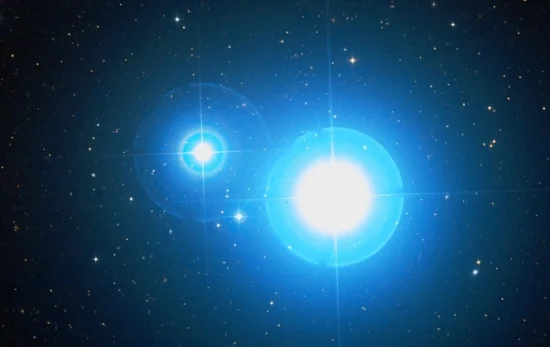
Alcor and Mizar, image: Wikisky
Mizar and Alcor were believed to be physically unrelated until 2009, when two teams of astronomers independently discovered not only that Alcor was a binary star itself with a faint red dwarf companion, but that it was gravitationally bound to Mizar. This would make the visual double a sextuple system, but it has not yet been proven beyond question that the stars really are gravitationally bound, mainly because the stars’ exact distances from Earth are still uncertain. The estimated distance between Mizar and Alcor is no more than 0.5 to 1.5 light years, or 74,000 ± 39,000 astronomical units. If both stars are located at the same distance from Earth (which is not very likely), then the estimated distance between them drops to only 0.281 light years, or 17,800 astronomical units.
Both stars are members of the Ursa Major Moving Group and share a common proper motion through space.
The two stars have been known since ancient times. They were nicknamed “horse and rider” in the Arabic-speaking world.
The stars are associated with the Mi’kmaq First Nations myth that explains why leaves turn red in the autumn and why the Big Dipper changes its position from one season to the next. In the myth, seven hunters (birds) are hunting the bear. The hunters are represented by the stars of the Big Dipper’s handle and four stars in the constellation Boötes, while the stars of the Dipper’s bowl represent the bear, and the semi-circular pattern of the constellation Corona Borealis outlines the bear’s cave. When the hunters finally catch the bear, its blood spatters over the trees, which is why the leaves turn red. The bear’s skeleton lies on its back all winter (when the Bear constellation appears upside down) until its spirit enters another bear that lies in the cave until the spring, when it leaves the cave and is hunted again. In the myth, Mizar represents Chickadee, one of the hunters, and Alcor his cooking pot, in which he cooks the bear.
Facts
Zeta Ursae Majoris was the first telescopic binary star discovered. It was most likely discovered by the Italian mathematician Benedetto Castelli, who asked his friend and teacher Galileo Galilei to observe the star in 1617. Galileo subsequently gave Castelli a detailed report on the binary star system.
Zeta1 Ursae Majoris was another first: the first spectroscopic binary star ever discovered. American astronomer Antonia Maury, who published a catalogue of stellar spectra in 1897, had observed periodic doubling in some of the star’s spectral lines and included her discovery – the first spectroscopic binary orbit – in her publication. The components of the system were imaged in 1996 using the Navy Prototype Optical Interferometer, an astronomical interferometer capable of exceptionally high resolution. The composite image of Mizar A shows the stars’ orbital motion.
Zeta2 Ursae Majoris was discovered to be a spectroscopic binary in 1908.
Mizar is a member of the Ursa Major Moving Group, a stellar association that also includes Big Dipper stars Alioth, Megrez, Phecda and Merak, as well as a number of bright stars in other constellations, among them Alphecca (Alpha Coronae Borealis), Skat (Delta Aquarii), Adhafera (Zeta Leonis), Menkalinan (Beta Aurigae), Beta Serpentis, Zeta Boötis A and Gamma Leporis A. These stars are believed to have formed in the same molecular cloud at around the same time and share common velocities and proper motion. Only two Big Dipper stars – Dubhe and Alkaid – are not members of the group, but as they are the westernmost and easternmost star in the asterism, and moving in opposite directions, the Big Dipper will eventually fall apart over time.
Name
The name Mizar (pronunciation: /ˈmaɪzɑːr/) comes from the Arabic miʼzar, meaning “cover,” “wrapper” or “apron.” It is the traditional name for the whole star system, but now only formally applies to the star Zeta Ursae Majoris Aa. The name was approved by the International Astronomical Union’s (IAU) Working Group on Star Names (WGSN) on June 30, 2016.
The Chinese know Mizar as the Sixth Star of Northern Dipper (北斗六) and the Star of The Opener of Heat (開陽). The Northern Dipper is a Chinese asterism that corresponds to the Big Dipper. In Chinese Taoism, Mizar is known as the star of Lu (禄) and associated with prosperity and influence.
In Indian astronomy, Mizar is known as Vashishtha, one of the Saptarishi (Seven Sages), credited as the main author of Mandala 7 (book 7) of Rigveda. Alcor is known as Arundhati, his wife. The two symbolize marriage and the closeness it brings to a couple.
Location
Mizar is easy to find because it is part of one of the best known asterisms in the sky. It is the middle star of the Big Dipper’s handle, which it forms with the brighter Alioth and Alkaid. The Big Dipper never sets for most northern observers and can be seen year-round. It is particularly prominent in the evening sky during the months of spring.
The stars forming the handle of the Big Dipper can be used to find Arcturus and Spica, the brightest stars in the constellations Boötes and Virgo. Arcturus, the brightest star in the northern celestial hemisphere and the fourth brightest star in the sky, is the first bright star that appears along the imaginary line that follows the arc of the Dipper’s handle. Spica, the 16th brightest star in the sky, is the second star to appear a bit further along the same line.
Mizar is located in the same area of the sky as two famous bright galaxies, the Pinwheel Galaxy (Messier 101) and the Whirlpool Galaxy (Messier 51). The Pinwheel Galaxy can be seen in a small telescope. It forms a triangle with Mizar and Alkaid above the Big Dipper‘s handle, about 5.5 degrees from each star. The grand design spiral galaxy M51 and its smaller companion NGC 5195, also visible in small telescopes, lie about 3.5 degrees southwest of Alkaid.
Constellation
Mizar is located in Ursa Major constellation, representing the Great Bear. Ursa Major is the third largest constellation in the sky and contains a number of well-known deep sky objects. These include the Pinwheel Galaxy (M101), the galaxy pair M81 and M82 (Bode’s Galaxy and the Cigar Galaxy), the barred spiral galaxies M108 and M109, and the planetary nebula M97, also known as the Owl Nebula.
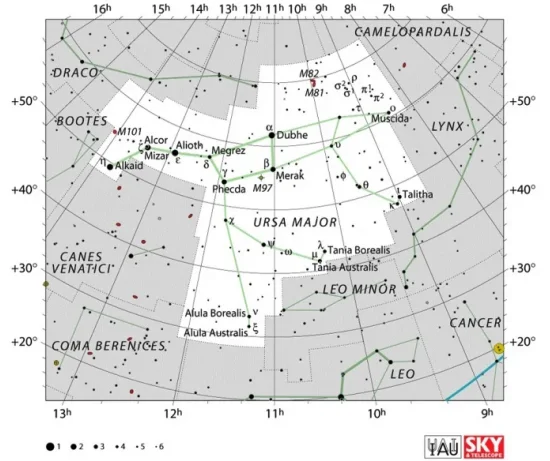
Ursa Major constellation map by IAU and Sky&Telescope magazine
The 10 brightest stars in Ursa Major are Alioth (Epsilon UMa, mag. 1.77), Dubhe (Alpha UMa, mag. 1.79), Alkaid (Eta UMa, mag. 1.86), Mizar (Zeta UMa, mag. 2.04), Merak (Beta UMa, mag. 2.37), Phecda (Gamma UMa, 2.438), Psi Ursae Majoris (mag. 3.01), Tania Australis (Mu UMa, mag. 3.06), Talitha (Iota UMa, mag. 3.14), and Theta Ursae Majoris (mag. 3.166).
Mizar – Zeta Ursae Majoris
| Apparent magnitude | 2.04 |
| Distance | 82.9 ± 0.6 light years (25.4 ± 0.2 parsecs) |
| Parallax | 39.36 ± 0.30 mas |
| Radial velocity | -6.31 km/s |
| Proper motion | RA: 119.01 mas/yr |
| Dec.: -25.97 mas/yr | |
| Constellation | Ursa Major |
| Right ascension | 13h 23m 55.54048s |
| Declination | +54° 55′ 31.2671” |
| Designations | Mizar, Zeta Ursae Majoris, ζ UMa, 79 Ursae Majoris, HIP 65378, CCDM J13240+5456, WDS J13239+5456, BD+55 1598, IRAS 13219+5511 |
Zeta1 Ursae Majoris
| Spectral class | A2Vp/A2Vp |
| U-B colour index | -0.01 |
| B-V colour index | +0.02 |
| Apparent magnitude | 2.23 |
| Absolute magnitude | +0.32 |
| Mass (ζ UMa Aa, ζ UMa Ab) | 2.2224 ± 0.0221 M☉, 2.2381 ± 0.0219 M☉ |
| Luminosity (ζ UMa Aa, ζ UMa Ab) | 33.3 ± 2.1 L☉, 33.3 ± 2.1 L☉ |
| Radius (ζ UMa Aa, ζ UMa Ab) | 2.4 ± 0.1 R☉, 2.4 ± 0.1 R☉ |
| Temperature (ζ UMa Aa, ζ UMa Ab) | 9,000 ± 200 K, 9,000 ± 200 K |
| Age (ζ UMa Aa, ζ UMa Ab) | 370 million years |
| Right ascension | 13h 23m 55.543s |
| Declination | +54° 55′ 31.30” |
| Designations | Zeta1 Ursae Majoris, Mizar A, HD 116656, GC 18133, SAO 28737, PPM 34007, HR 5054, FK5 497, GCRV 7958, GJ 3783, TYC 3850-1385-1, WDS J13239+5456A |
Zeta2 Ursae Majoris
| Spectral class | kA1h(eA)mA7IV-V |
| U-B colour index | +0.09 |
| B-V colour index | +0.13 |
| Apparent magnitude | 3.88 |
| Absolute magnitude | +1.96 |
| Temperature | 8,425 K |
| Rotational velocity | 61 km/s |
| Surface gravity | 4.40 cgs |
| Right ascension | 13h 23m 56.330s |
| Declination | +54° 55′ 18.56” |
| Designations | Zeta2 Ursae Majoris, Mizar B, HD 116657, GC 18134, SAO 28738, HR 5055, GJ 3784, GCRV 7959, TYC 3850-1386-1, Gaia DR2 1563590510625852544, WDS J13239+5456B |
